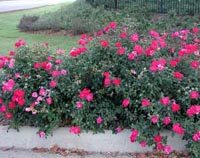Resource Library
Plant of the Week: Rose, Knock Out
The University of Arkansas System Division of Agriculture does not promote, support or recommend plants featured in "Plant of the Week." Please consult your local Extension office for plants suitable for your region.
Plant of the Week
Knock Out Rose
Latin: PP 11,836 ctv. ‘Radrazz’

It seems roses are back. True, they never completely disappeared, but roses had lost a lot of their appeal amongst everyday gardeners. They were just too much work. But, that all changed with Knock Out rose, now perhaps the hottest thing to ever hit the rose world.
Knock Out (PP 11,836 ctv. ‘Radrazz’) is a shrub rose that grows about 3 feet tall and wide. It produces terminal clusters of single, 3-inch diameter cherry red blooms. As long as it continues to grow through the summer, it will continue to bloom. Some claim it’s one of the longest blooming roses on the market. It’s not well suited for use as a cut flower and the blooms only have a light tea rose fragrance.
Knock Out rose was developed by Wisconsin rose breeder William Radler who has been growing roses since his youth. He was the long time director of the Boerner Botanical Garden in Minneapolis and has recently served as consulting rosarian for the Chicago Botanical Garden.
His breeding efforts began about 20 years ago and focused on developing repeat blooming, cold hardy roses that didn’t get disease, especially black spot. In the early stages of his breeding career, he raised about 600 seedlings a year under fluorescent lights in his basement.
In 1988, Radler crossed seedlings of Carefree Beauty and Razzle Dazzle, both hardy roses with good disease resistance. In 1992, the Conard-Pyle Company / Star Roses began testing the plant. In 2000, it won the prestigious All-America Rose award, and the company introduced it that same year. Knock Out quickly became the fastest selling new rose in history, with 250,000 sold the first year alone.
Part of Knock Out’s success is because of the well honed marketing skills of the Star Rose people. But a lot of it is because Knock Out is just a great rose. Reports from about anywhere roses are grown indicate it is disease resistant and just keeps blooming.
Radler took no chances when selecting for disease resistance. To make sure conditions were favorable for encouraging black spot and other rose diseases, Radler watered his plants using an overhead sprinkler. Then, for good measure, he ground diseased rose leaves in his kitchen blender to intentionally inoculate the plants.
The principle of breeding and selecting plants in an environment where the plant is to grow is certainly not new, but many rose breeding companies ignored the principle. Until recent years, most roses were bred in California where disease pressure was almost nonexistent and winters were a distant memory. No wonder rose growers had become so frustrated with modern roses.
Knock Out roses will probably become a commonplace addition to our landscapes, much as has happened with spireas, dwarf nandina, Bradford pears, Stella de ’Oro daylilies and other such mass-produced plants that are easy to grow and widely adaptable. Radler has introduced a number of sister lines, including the Double Knock Out, that will be more widely available next spring.
Like most roses, Knock Out is best in full sun or light shade in a fertile, well drained soil. These are shrub roses, so their wintertime appearance leaves a bit to be desired, so use it amongst low evergreen shrubs to compensate for its winter nakedness. Prune it in the spring just before new growth starts as you would other shrub roses. Prune during the growing season as needed to control size. Water and fertilize as the season progresses to ensure plants continue to grow and set new flower buds.
Knock Out rose was selected as an Arkansas Select plant for 2005.
By: Gerald Klingaman, retired
Extension Horticulturist - Ornamentals
Extension News - November 11, 2005
The University of Arkansas System Division of Agriculture does not maintain lists of retail outlets where these plants can be purchased. Please check your local nursery or other retail outlets to ask about the availability of these plants for your growing area.